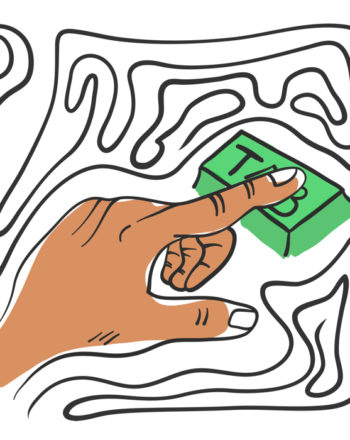Pin pointing exactly what a client wants and needs for their new website can be difficult. Therefore, it is important to make sure that before you start work on their project, you have a good understanding of their business, their audience, and what they want to achieve with their new website.
All website’s should be working towards achieving key goals
Asking a client to answer the key questions listed below will immediately make your job as a designer easier. It will also help in the long term, as if your client is unhappy with the final product, you will be able look back at their requirements and remind them of their initial requests.
Ultimately, an in-depth discussion at the beginning of a working relationship will help you understand the needs of your client and improve your final design. So let’s have a look at the questions that you need to be asking…
1. What Does Your Business Actually Do?
Understanding exactly what a client’s business does is imperative. Make sure you have as full a picture as possible, from the size, location and background of a company, to what they sell, who their customers are, and what their vision is for the future.
Learning the ins and outs of a business’s history, ethos and mission, as well as reviewing their customer base, will help you create the design and branding of the site. And information on how the company generates revenue, and what they are looking to achieve with their website, will impact the features and functionalities that you decide to use. The more information you have on a business the better, so take your time getting to know a company before you start work.
2. What Do You Want Your Site to Achieve?
All website’s should be working towards achieving key goals. Although some of these goals will change over time, the primary objectives of a website should be set in stone.
For example, the primary aims of a business’s website may be to sell products online, generate leads for a brick and mortar service, or to raise awareness of their company. Whatever a client’s site is trying to achieve, it is important that you are aware of its goals and tailor the site’s design accordingly.
3. Do You Already Have an Existing Website?
If a client already has an existing website then you can use this to learn about their likes and dislikes. Ask them about the design, layout and usability, what they would like to keep, and what needs improvement.
If your client has analytics reporting setup, look carefully at the site’s performance to see what content the audience responded well to and what has generated results. By having a good overview of the previous website, you will be able to design a site that is more fit for purpose, and in line with your client’s wishes.
4. What Makes Your Company Unique?
It is crucial that you get to grips with what makes a client’s business unique. Is it their high standard of product, their speedy service, or their invaluable customer care?
The competition online is fierce, and more than likely your client’s website will be just one of many in their field. Therefore, any stand out qualities that you can promote on-site will help your client stand out from the crowd. Once you understand what your client’s unique selling points are, you can use them to your advantage within the new design.
5. Who Are Your Competitors?
Always check with clients who their main competitors are. Together, have a look at the websites of the competition and go through what they like and don’t like on those websites. These are all ideas you can integrate into your design.
An in-depth understanding of the competition, and what a client offers in relation to their rivals will help give you an idea of what you need to include in your website design. It may also give insight into what your client’s audience responds well to, which should help to influence your design process.
6. What Websites Do You Like and Why?
Leading on from the last question, generate a discussion over what website features your client likes. Look further afield at other websites and discuss a range of different designs, layouts, branding, and more.
Discuss what design elements you think will appeal to your client’s audience. Share your own thoughts on the matter and try to ascertain your client’s ideas. Looking at examples of other websites will help you to lock down exactly what a client want for their website.
7. Who Exactly Are Your Customers?
The website you are creating has to be successful, in that it helps your client’s business to convert against its goals. To do this, the website needs to engage directly with the client’s target audience.
Quizz your client on their ideal consumer until you have a clear and precise image of who their business is selling to. Ask about the age, location and demographics of their target market. And learn the reasons users will have for visiting your client’s website, using their services, or buying their products. The more you understand the needs of your client’s target audience, the easier it will be to create a website catering specifically for them.
8. What Features Do You Want Your Website to Have?
Create a definitive list with your clients, incorporating all the features they want included in their website. Ask them to explain or show examples of features and functionalities they would like for their site. And discuss with them any key features that you think they may need but haven’t mentioned.
Don’t use jargon during this process, as often clients will not know the correct terminology of many of the features you mention. Using layman’s terms, and examples from other websites, is the best way to fully understand each other.
9. What Does Success Look Like?
Ask your clients if they have a clear vision of what success looks like for their website. And if it can be measured. Success should be directly linked to the website’s goals that we spoke about earlier.
For example, success could be collecting emails, an increase in product sales, or higher traffic numbers. Discuss with your clients which design elements you could to use to help their website achieve and monitor these goals.
10. Do You Have a Style Guide?
Trying to capture the ‘right’ style for a client can be the hardest part of web design. Check with them to see if they have an existing style guide, and if so how closely they want it adhered to.
If there is no style guide, ask to see any other promotional material they may have, like brochures, logos, or their old website. Again discuss with your clients what elements of the branding and aesthetics they like, and what you can have free reign on to change.
Final Thoughts
Discussing these questions will ensure that you understand what your clients are wanting to achieve. You should now have enough information to go ahead and design a beautiful and built-for-purpose website. One that will not just impress your clients, but deliver well beyond expectations. Time to Get to Work!
Maintenance and Support
Maintenance and support service, tailored for
Digital Marketing specialists.








